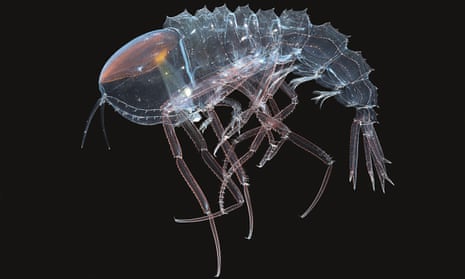The inky depths of the ocean’s twilight zone are home to fist-sized shrimp-like crustaceans with ridiculously big eyes. Most of Cystisoma’s head is taken up by its eyes – all the better for seeing in the dark. “The bigger you make your eye, the more likely you are to catch any photons that are out there,” says Karen Osborn, research scientist at the Smithsonian Institution in Washington DC.
Q&AWhat is the Discovered in the deep series?
Show
The ocean is one of the world’s last truly wild spaces. It teems with fascinating species that sometimes seems to border on the absurd, from fish that look up through transparent heads to golden snails with iron armour. We know more about deep space than deep oceans, and science is only beginning to scratch the surface of the rich variety of life in the depths.
As mining companies push to industrialise the sea floor and global leaders continue to squabble over how to protect the high seas, the Guardian's Seascape series, Discovered in the deep, will profile some of the most recently discovered weird, wonderful, majestic, ridiculous, hardcore and mind-blowing creatures. They reveal how much there is still to learn about the least known environment on Earth – and how much there is to protect.
A big challenge for animals living in deep midwater, in Cystisoma’s case between 200 and 900 metres down, is to see while not being seen by predators. “It’s basically like playing hide and seek on a football field,” says Osborn. “There’s nothing to duck behind.”
Eyes are especially hard to hide because retinas always have to contain dark, photon-absorbing pigments, which predators can either make out in the dim twilight zone illumination, or in the beams of their own bioluminescent searchlights. Cystisoma disguises its huge eyes in a unique way. Instead of concentrating the pigments in a small area, Osborn says, they spread their retina into a thin sheet of tiny reddish dots that are too small for most animals to see.
Cystisoma hides most of the rest of its body by being completely transparent. When scientists catch them in trawl nets and empty them into a bucket of seawater, they appear as empty, palm-sized gaps between other animals. “You really cannot see these things until you pick them out of the water,” says Osborn.
Most of Cystisoma’s internal organs appear crystal-clear thanks to the very orderly, structured way their tissues are arranged, Osborn explains. “The only thing they can’t seem to do it very well with is their gut,” she says. The golden structure visible beneath the eyes is the digestive organ. Even this is stacked tall and straight to cast as small a shadow as possible while Cystisoma hangs in its usual horizontal position.

These crustaceans make themselves even harder to spot underwater by reducing the light that reflects off their transparent bodies, Osborn and colleagues discovered in 2016. Seen under an electron microscope, parts of Cystisoma’s exoskeleton are covered in tiny protuberances, which Osborn likens to a shag-pile carpet. Other parts are covered in a single layer of spherical shapes, which the scientists think could be colonies of an unknown form of bacteria.
The nanoscopic shag-pile carpet and spheres make light 100 times more likely to pass straight through Cystisoma, rather than reflect into the eye of a passing predator. “It works in exactly the same way as an anti-reflective coating on a camera lens,” says Osborn.
Cystisoma’s legs in particular benefit from the anti-reflection shag-pile covering and sphere-covered joints, because otherwise they would easily catch the light as they flick and wriggle about. “These guys are absolute masters of transparent camouflage out in the midwater.”
But what happens when the near-invisible Cystisoma actually wants to be found? These crustaceans need to pair up to reproduce. A clue as to how mates find each other is in the male Cystisoma’s large antennae covered in structures that detect chemicals in the surrounding water. “They’re actually smelling each other,” says Osborn.
